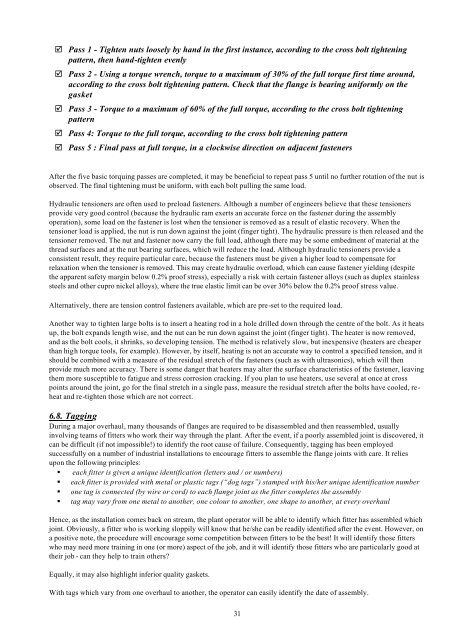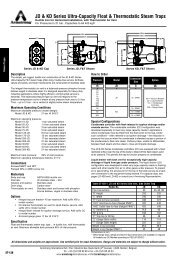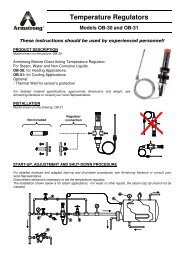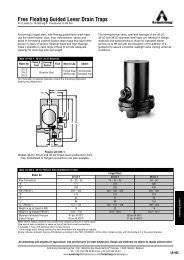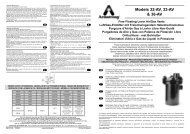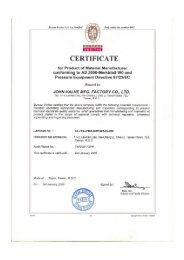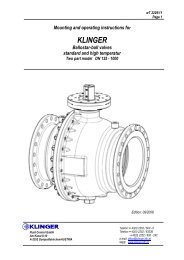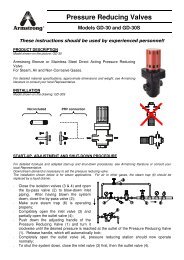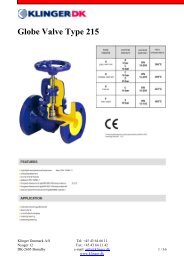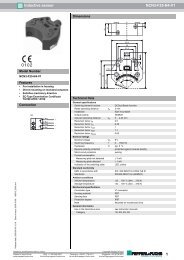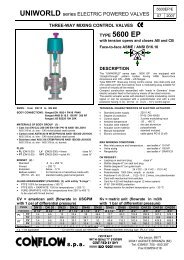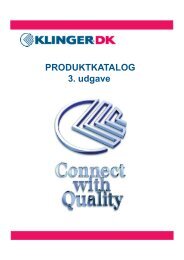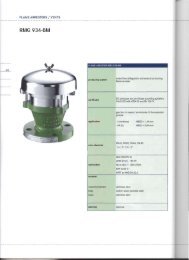Guidelines for safe seal usage - Klinger AG Egliswil
Guidelines for safe seal usage - Klinger AG Egliswil
Guidelines for safe seal usage - Klinger AG Egliswil
You also want an ePaper? Increase the reach of your titles
YUMPU automatically turns print PDFs into web optimized ePapers that Google loves.
þ Pass 1 - Tighten nuts loosely by hand in the first instance, according to the cross bolt tightening<br />
pattern, then hand-tighten evenly<br />
þ Pass 2 - Using a torque wrench, torque to a maximum of 30% of the full torque first time around,<br />
according to the cross bolt tightening pattern. Check that the flange is bearing uni<strong>for</strong>mly on the<br />
gasket<br />
þ Pass 3 - Torque to a maximum of 60% of the full torque, according to the cross bolt tightening<br />
pattern<br />
þ Pass 4: Torque to the full torque, according to the cross bolt tightening pattern<br />
þ Pass 5 : Final pass at full torque, in a clockwise direction on adjacent fasteners<br />
After the five basic torquing passes are completed, it may be beneficial to repeat pass 5 until no further rotation of the nut is<br />
observed. The final tightening must be uni<strong>for</strong>m, with each bolt pulling the same load.<br />
Hydraulic tensioners are often used to preload fasteners. Although a number of engineers believe that these tensioners<br />
provide very good control (because the hydraulic ram exerts an accurate <strong>for</strong>ce on the fastener during the assembly<br />
operation), some load on the fastener is lost when the tensioner is removed as a result of elastic recovery. When the<br />
tensioner load is applied, the nut is run down against the joint (finger tight). The hydraulic pressure is then released and the<br />
tensioner removed. The nut and fastener now carry the full load, although there may be some embedment of material at the<br />
thread surfaces and at the nut bearing surfaces, which will reduce the load. Although hydraulic tensioners provide a<br />
consistent result, they require particular care, because the fasteners must be given a higher load to compensate <strong>for</strong><br />
relaxation when the tensioner is removed. This may create hydraulic overload, which can cause fastener yielding (despite<br />
the apparent <strong>safe</strong>ty margin below 0.2% proof stress), especially a risk with certain fastener alloys (such as duplex stainless<br />
steels and other cupro nickel alloys), where the true elastic limit can be over 30% below the 0.2% proof stress value.<br />
Alternatively, there are tension control fasteners available, which are pre-set to the required load.<br />
Another way to tighten large bolts is to insert a heating rod in a hole drilled down through the centre of the bolt. As it heats<br />
up, the bolt expands length wise, and the nut can be run down against the joint (finger tight). The heater is now removed,<br />
and as the bolt cools, it shrinks, so developing tension. The method is relatively slow, but inexpensive (heaters are cheaper<br />
than high torque tools, <strong>for</strong> example). However, by itself, heating is not an accurate way to control a specified tension, and it<br />
should be combined with a measure of the residual stretch of the fasteners (such as with ultrasonics), which will then<br />
provide much more accuracy. There is some danger that heaters may alter the surface characteristics of the fastener, leaving<br />
them more susceptible to fatigue and stress corrosion cracking. If you plan to use heaters, use several at once at cross<br />
points around the joint, go <strong>for</strong> the final stretch in a single pass, measure the residual stretch after the bolts have cooled, reheat<br />
and re-tighten those which are not correct.<br />
6.8. Tagging<br />
During a major overhaul, many thousands of flanges are required to be disassembled and then reassembled, usually<br />
involving teams of fitters who work their way through the plant. After the event, if a poorly assembled joint is discovered, it<br />
can be difficult (if not impossible!) to identify the root cause of failure. Consequently, tagging has been employed<br />
successfully on a number of industrial installations to encourage fitters to assemble the flange joints with care. It relies<br />
upon the following principles:<br />
• each fitter is given a unique identification (letters and / or numbers)<br />
• each fitter is provided with metal or plastic tags (“dog tags”) stamped with his/her unique identification number<br />
• one tag is connected (by wire or cord) to each flange joint as the fitter completes the assembly<br />
• tag may vary from one metal to another, one colour to another, one shape to another, at every overhaul<br />
Hence, as the installation comes back on stream, the plant operator will be able to identify which fitter has assembled which<br />
joint. Obviously, a fitter who is working sloppily will know that he/she can be readily identified after the event. However, on<br />
a positive note, the procedure will encourage some competition between fitters to be the best! It will identify those fitters<br />
who may need more training in one (or more) aspect of the job, and it will identify those fitters who are particularly good at<br />
their job - can they help to train others?<br />
Equally, it may also highlight inferior quality gaskets.<br />
With tags which vary from one overhaul to another, the operator can easily identify the date of assembly.<br />
31


